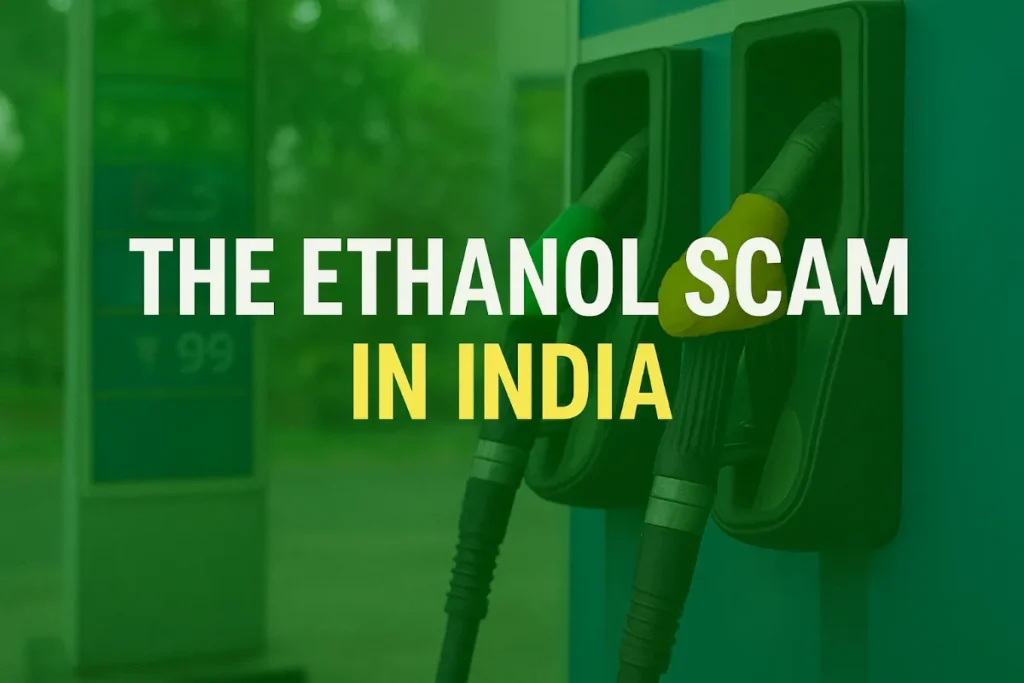India’s ethanol blending success hides a bigger problem. The ethanol scam exposes rising fuel prices, consumer exploitation, and favoritism.
Introduction: A Green Revolution with a Dark Side
When the Indian government proudly announced that it had achieved 20% ethanol blending in petrol (E20) five years ahead of schedule, the headlines painted it as a historic win. The promise was clear: billions saved in foreign exchange, reduced dependence on crude oil, and a greener future.
But beneath the celebratory noise lies a growing discontent among vehicle owners, consumers, and even experts. Instead of being a win-win, many are now calling it the ethanol scam—a scheme that has burdened citizens with higher costs, poor fuel performance, and corporate favoritism disguised as a green revolution much outperforming even the prevalent online scams in India.
Let’s break it down.
The Big Promise vs. the Harsh Reality
India’s early achievement in hitting its E20 target should have translated into lower petrol prices. If ethanol—cheaper than imported crude—makes up 20% of the fuel mix, why hasn’t the average Indian seen relief at the pump?
Analysts suggest petrol should have been ₹5–₹6 cheaper per liter. Instead, consumers continue to pay record-high prices. The ethanol scam isn’t about ethanol itself, but about how the benefits of this policy never reached the common man. The government saves ₹1,36,000 crore annually in foreign exchange, but where did those savings go?
Mislabeling and Lack of Transparency
Another red flag in this ethanol scam is the lack of awareness among consumers. Most people don’t even know whether they’re filling E10, E20, or regular petrol in their vehicles.
Worse, even premium fuels like XP95, which are sold at higher prices for “better performance,” are blended with ethanol. That means consumers are paying a premium for something that doesn’t deliver the promised value. Isn’t that misleading, if not outright fraudulent?
Transparency should be non-negotiable when it comes to fuel quality. Yet, the labeling at pumps remains murky, and the average motorist is kept in the dark.
Vehicle Performance Takes a Hit
One of the loudest complaints from vehicle owners has been about reduced mileage and poor performance. Ethanol burns faster than petrol, which means cars and bikes consume more fuel for the same distance.
The government itself admits that older engines not designed for E20 may experience a drop in average. But here’s the catch—what about millions of Indians still driving older vehicles? Should they be forced into higher running costs without choice?
The fair solution would have been to offer consumers options—separate pumps for E0, E10, and E20 fuels. Instead, the ethanol scam ensures everyone pays the price, literally and figuratively.
The Corporate Angle: Who Really Benefits?
This is where the ethanol scam starts looking like classic crony capitalism. While over 500 companies produce ethanol in India, one company—Sian (सीयान)—has been at the center of repeated tenders.
The results?
- Sian’s share price skyrocketed by 520% in just one year.
- Its turnover jumped from ₹17 crore to ₹500+ crore almost overnight.
Coincidence? Unlikely. The pattern suggests favoritism in awarding tenders, where a handful of players profit while the rest of the industry is sidelined. If ethanol blending was truly a national initiative, why aren’t the benefits spread more evenly among producers?
Why Consumers Should Care
Critics argue that the ethanol scam is not just about numbers—it’s about trust. Indians were told this was a green initiative to help the planet and the economy. Instead, it feels like consumers are footing the bill while corporations and policymakers reap the rewards.
Every time you fill your tank, you’re not just paying for fuel—you’re unknowingly part of an experiment that may be damaging your engine, reducing your mileage, and draining your wallet.
The Ethanol Scam in Numbers
- ₹1,36,000 crore saved annually in foreign exchange—yet petrol prices remain sky-high.
- 20% ethanol blending achieved five years early—but no visible consumer benefit.
- 520% rise in one company’s share value, raising serious questions of favoritism.
- Millions of older vehicles at risk of poor mileage and performance.
Numbers don’t lie. They tell a story of a policy that looks good on paper but stinks of exploitation in practice.
The Bigger Picture: A Scam Disguised as Sustainability
The ethanol blending program was supposed to be about energy security and sustainability. But the way it has been executed makes it look more like a classic case of policy capture—where a few corporations benefit while ordinary citizens bear the brunt.
And that, in essence, is why many are calling it the ethanol scam. It’s not ethanol that’s the villain—it’s the opaque way the policy has been rolled out, without safeguards for transparency, consumer choice, or fair competition.
Conclusion: Demand Accountability, Not Greenwashing
India deserves clean energy solutions, but not at the cost of consumer exploitation. The ethanol scam shows us how good intentions can be hijacked by poor execution and possible favoritism.
As citizens, we must ask the right questions:
- Where are the promised price reductions?
- Why isn’t labeling at pumps transparent?
- Why are consumers forced into a one-size-fits-all policy?
- And why does one company benefit disproportionately?
Until these questions are answered, the ethanol program will remain less of a green revolution and more of a greenwashed scam.
FAQs on the Ethanol Scam
1. What is the ethanol scam in India?
The ethanol scam refers to allegations that India’s ethanol blending program, while saving foreign exchange, has not lowered fuel prices, has reduced vehicle performance, and disproportionately benefited certain companies.
2. Why hasn’t petrol become cheaper despite ethanol blending?
Although ethanol is cheaper than imported crude, petrol prices have not fallen. The government saves money, but these savings are not passed on to consumers.
3. How does ethanol affect vehicle performance?
Ethanol has a lower energy density than petrol, meaning it burns faster and reduces mileage, especially in older engines not designed for E20 fuel.
4. Is premium petrol like XP95 also blended with ethanol?
Yes, even premium petrols are blended with ethanol, despite being sold at higher prices—leading to allegations of consumer misrepresentation.
5. Why is Sian company linked to the ethanol scam?
Sian has allegedly received repeated tenders, with its share price soaring 520% and turnover jumping from ₹17 crore to ₹500+ crore in one year, raising questions of favoritism.
6. Are all ethanol producers benefiting equally?
No. Although 500+ companies produce ethanol, tenders are often concentrated with a few players, creating an uneven playing field.
7. Can ethanol damage older vehicles?
Yes. Engines not designed for E20 fuel can experience lower mileage and possible wear-and-tear issues.
8. Why aren’t different petrol options available at pumps?
Ideally, pumps should offer E0, E10, and E20 options. But currently, consumers often have no choice, which is a key criticism of the ethanol scam.
9. How much money does the government save through ethanol blending?
Around ₹1,36,000 crore annually in foreign exchange—but this saving hasn’t translated into lower consumer fuel prices.
10. What can consumers do about the ethanol scam?
Consumers can demand transparency, push for labeling reforms, and hold policymakers accountable for ensuring that green policies don’t turn into scams.



